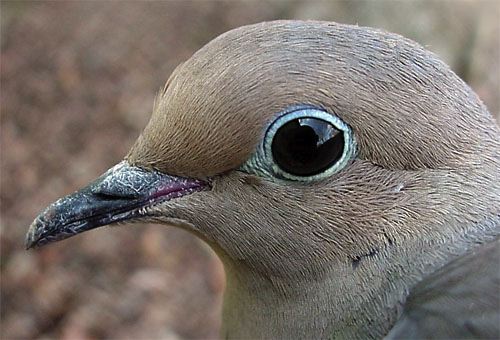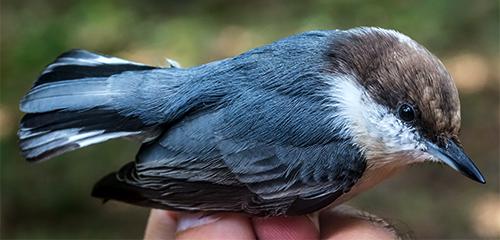- Established 1982 -HOME: www.hiltonpond.org
THIS WEEK at HILTON POND Subscribe for free to our award-winning nature newsletter (Back to Preceding Week; on to Next Week) |
All text, maps, charts & photos © Hilton Pond Center LONESOME DOVE? Although they're not what we'd call abundant at Hilton Pond Center, Mourning Doves (MODO) are still locally common. Nearly every day we see at least a couple or three foraging on leftover scraps and roughage beneath seed feeders frequented by Carolina Chickadees, Northern Cardinals, House Finches, and the like. Of 127 species banded at the Center since 1982, MODO are the 15th most frequently captured; as of 7 March 2022; they're tied with Eastern Towhees at 756--each species making up about 1% of our 75,465 total bandings.
All text, maps, charts & photos © Hilton Pond Center Mourning Doves are indeed plentiful, and widespread. Some field ornithologists list MODO as the second-most-common avian species in North America (including Mexico) at 350 million individuals (far behind Dark-eyed Juncos, whose estimated 630 million is hard to imagine). These cosmopolitan doves have a huge breeding range (peach and purple on the map above) and may move as far south as western Panama in winter (blue). Even so, many Mourning Doves are likely year-round residents (purple) at or near locations where they hatched. To our knowledge, no one has ever had a long-distance encounter with a Mourning Dove banded at Hilton Pond Center, so we're reasonably sure local birds aren't wandering far. As additional evidence, 11 of our banded MODO have been reported less than ten miles away within our home county of York, and all were shot by hunters. (Doves can be hunted legally in 42 states including South Carolina, giving game shooters an annual nationwide harvest of about 20 million birds. Not coincidentally, there are several public dove fields with ten miles of the Center.) Most of Hilton Pond's MODO encounters were relatively young birds just a year or two old when taken, but two longer-lived doves were of particular interest:
All text, maps, charts & photos © Hilton Pond Center We were pretty impressed with the two older birds listed above, especially since Mourning Doves--as game birds--undoubtedly have a higher mortality risk than non-game species. Even more impressive, however, was a MODO (above) we caught this week (5 March) in one of the Center's mist nets. This bird, which already had a band on its left leg, lay passively in the mesh as we carefully extracted it. We knew right off it was an adult male because of his rosy breast wash, extensive pink and gold iridescence on the neck, and prominent slate blue crown (brownish in females, as in our file photo below),
All text, maps, charts & photos © Hilton Pond Center With the just-captured dove securely in hand we read the band prefix and number (#1343-85667) and recognized it as one we had used at the Center--albeit not in recent years. When we consulted our extensive database we got quite a jolt: This Mourning Dove was first caught here in a ground trap as an after-hatch year male on 2 January 2015. This meant he was now an after-ninth-year bird in at least his tenth year, by far the oldest of his species in our 41 years of work at Hilton Pond! A further check of our records showed we recaptured this venerable individual in April 2019, August 2020, and March 2021--pretty good evidence he's been a year-round local resident for his entire life. (Interestingly, all four recaptures-- including the latest one--were in the very same mist net location just outside our office window.) Despite our excitement at recapturing a Mourning Dove that has been hanging around for at least a decade, a check of the Bird Banding Lab's longevity tables revealed MODO that were much older. Take, for example, a male banded in Georgia in 1968 and short 30 years later in Florida! (Phenomenal!) There was also a young Mourning Dove banded in Colorado in 1958 and shot 19 years later in Guatemala! (Wow!) And what about the long-distance flier (a young male) banded in 1968 in Minnesota and taken by a hunter ten years later in Mexico! (Amazing!) Our Hilton Pond "oldster" has a ways to go to catch these three doves in both age and flight path.
All text, maps, charts & photos © Hilton Pond Center This week's MODO recapture came when we opened the back door of the Center's old farmhouse and accidentally spooked the dove into the mist net. A second Mourning Dove bounced out of the same mesh and flew off to a nearby tree, where it sat until the banded bird was released and the two flew off in the same direction. Was this other dove the old male's mate? If so, was she as old as he? We're not likely to be able to answer that question, but if the male MODO has been around for at least ten years we suspect he has fathered many offspring through all those breeding seasons. So is he a "lonesome dove" at Hilton Pond Center? We seriously doubt it, especially if he has a loyal female--plus 350 million other Mourning Doves to hang around with across North America. All text, maps, charts & photos © Hilton Pond Center AND AN OLD NUTHATCH And speaking of old birds, this week we recaptured a trio of relatively uncommon Brown-headed Nuthatches (BHNU) at the Center. Two were youngsters hatched and banded last summer, while the other was first caught as a hatch-year bird in September 2017 and is now in its sixth year. (NOTE: The Bird Banding Lab [BBL] calculates likely age of this particular BHNU as four years nine months. Regardless, the oldest Brown-headed Nuthatch on record at the BBL is an Alabama bird aged just five years nine months, so ours is getting pretty close.)
All text, maps, charts & photos © Hilton Pond Center We don't have a big local population of Brown-headed Nuthatches (above)--only 56 banded in 41 years--and their numbers are even smaller than before 1994-95 when a 60-acre pine plantation on neighboring properly was clear-cut for lumber. Pine-loving BHNU breed in the Southeastern U.S. and are non-migratory, so the good news is at least two fledglings from 2020 made it through the winter AND an old bird that's likely an on-site breeder continues hanging around Hilton Pond Around Center property we've erected several BHNU wooden nest boxes with 1-1/8" holes--smaller than 1-1/2" openings preferred by Eastern Bluebirds. Now might be a good time for you to make and hang your own boxes in semi-open habitat if you have pine woods nearby and want to attract nesting Brown-headed Nuthatches. (CAVEAT: BHNU are known to begin nest construction as early as December, even though laying may not commence until May. In any case, time's a-wastin'!) To improve nesting success, consider installing a predator guard to protect eggs and nestlings from climbing snakes and various mammals. All text, maps, charts & photos © Hilton Pond Center LATE WINTER FINCH INFLUX (AND DEPARTURE) Incoming Purple Finches (PUFI) continued to surprise us during late winter 2022 at Hilton Pond Center, with new, unbanded birds still arriving in good numbers from who knows where. On 5 March a total of 25 PUFI crossed the banding table--the largest flock so far during the current season; these included 22 bandings and three same-season recaptures. Only two were adult males in raspberry plumage (see photo below), and most were young, unknown-sex, second-year birds in brown attire.
All text, maps, charts & photos © Hilton Pond Center The 50-plus American Goldfinches (AMGO) that were devouring thistle seed here in late February were essentially gone by the first week in March--we banded just one second-year male AMGO on the 5th among all those PUFI. We did capture three new House finches this week (two males, one female) that have been scarce all winter. And then, two days after we banded that big flock on 5 March the Purple Finches essentially disappeared--just like the goldfinches several days prior--leaving no more than a half dozen PUFI at our Hilton Pond feeders. We suspect they'll all be gone by month's end, if not before. All text, maps, charts & photos © Hilton Pond Center HILTON POND SUNSETS "Never trust a person too lazy to get up for sunrise
All text, maps, charts & photos © Hilton Pond Center Sunset over Hilton Pond, 04 March 2022 This day's photo is for 5th grade granddaughter McKinley Ballard Hilton, who--thanks to an interest in cloud-watching sparked by her science teacher--is considering a career in meteorology. This image looks to us like it depicts a series of ever-widening contrails. Don't forget to scroll down for lists of Hilton Pond supporters and of all birds banded and recaptured during the period. Photoshop image post-processing for this page employs |
|---|
|
"This Week at Hilton Pond" is written and photographed by Dr. Bill Hilton Jr., executive director of Hilton Pond Center for Piedmont Natural History
|
|
|
Please refer "This Week at Hilton Pond" to others by clicking on this button: |
|


















 Oct 15 to Mar 15:
Oct 15 to Mar 15: